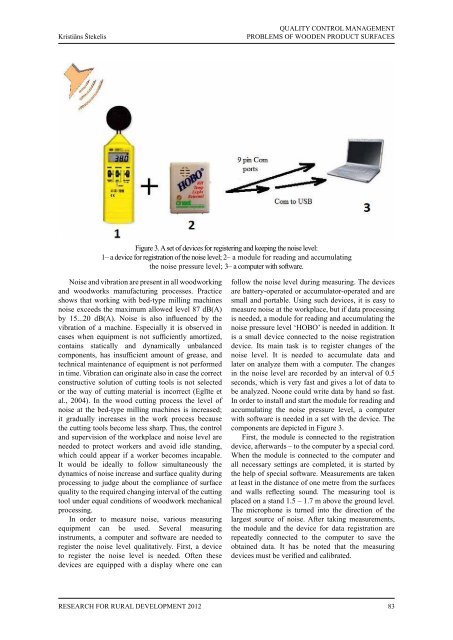RESEARCH FOR
RESEARCH FOR
RESEARCH FOR
Create successful ePaper yourself
Turn your PDF publications into a flip-book with our unique Google optimized e-Paper software.
Kristiāns Štekelis<br />
Noise and vibration are present in all woodworking<br />
and woodworks manufacturing processes. Practice<br />
shows that working with bed-type milling machines<br />
noise exceeds the maximum allowed level 87 dB(A)<br />
by 15...20 dB(A). Noise is also influenced by the<br />
vibration of a machine. Especially it is observed in<br />
cases when equipment is not sufficiently amortized,<br />
contains statically and dynamically unbalanced<br />
components, has insufficient amount of grease, and<br />
technical maintenance of equipment is not performed<br />
in time. Vibration can originate also in case the correct<br />
constructive solution of cutting tools is not selected<br />
or the way of cutting material is incorrect (Eglīte et<br />
al., 2004). In the wood cutting process the level of<br />
noise at the bed-type milling machines is increased;<br />
it gradually increases in the work process because<br />
the cutting tools become less sharp. Thus, the control<br />
and supervision of the workplace and noise level are<br />
needed to protect workers and avoid idle standing,<br />
which could appear if a worker becomes incapable.<br />
It would be ideally to follow simultaneously the<br />
dynamics of noise increase and surface quality during<br />
processing to judge about the compliance of surface<br />
quality to the required changing interval of the cutting<br />
tool under equal conditions of woodwork mechanical<br />
processing.<br />
In order to measure noise, various measuring<br />
equipment can be used. Several measuring<br />
instruments, a computer and software are needed to<br />
register the noise level qualitatively. First, a device<br />
to register the noise level is needed. Often these<br />
devices are equipped with a display where one can<br />
ReseaRch foR RuRal Development 2012<br />
QUALITY CONTROL MANAGEMENT<br />
PROBLEMS OF WOODEN PRODUCT SURFACES<br />
Figure 3. A set of devices for registering and keeping the noise level:<br />
1– a device for registration of the noise level; 2– a module for reading and accumulating<br />
the noise pressure level; 3– a computer with software.<br />
follow the noise level during measuring. The devices<br />
are battery-operated or accumulator-operated and are<br />
small and portable. Using such devices, it is easy to<br />
measure noise at the workplace, but if data processing<br />
is needed, a module for reading and accumulating the<br />
noise pressure level ‘HOBO’ is needed in addition. It<br />
is a small device connected to the noise registration<br />
device. Its main task is to register changes of the<br />
noise level. It is needed to accumulate data and<br />
later on analyze them with a computer. The changes<br />
in the noise level are recorded by an interval of 0.5<br />
seconds, which is very fast and gives a lot of data to<br />
be analyzed. Noone could write data by hand so fast.<br />
In order to install and start the module for reading and<br />
accumulating the noise pressure level, a computer<br />
with software is needed in a set with the device. The<br />
components are depicted in Figure 3.<br />
First, the module is connected to the registration<br />
device, afterwards – to the computer by a special cord.<br />
When the module is connected to the computer and<br />
all necessary settings are completed, it is started by<br />
the help of special software. Measurements are taken<br />
at least in the distance of one metre from the surfaces<br />
and walls reflecting sound. The measuring tool is<br />
placed on a stand 1.5 – 1.7 m above the ground level.<br />
The microphone is turned into the direction of the<br />
largest source of noise. After taking measurements,<br />
the module and the device for data registration are<br />
repeatedly connected to the computer to save the<br />
obtained data. It has be noted that the measuring<br />
devices must be verified and calibrated.<br />
83


